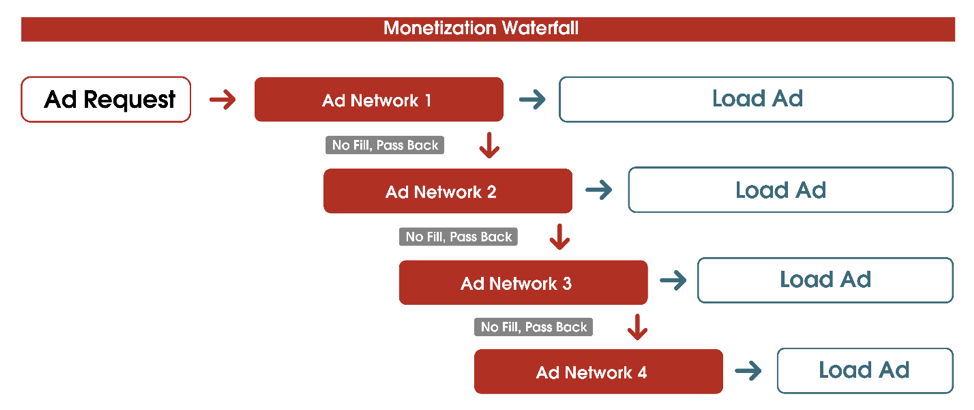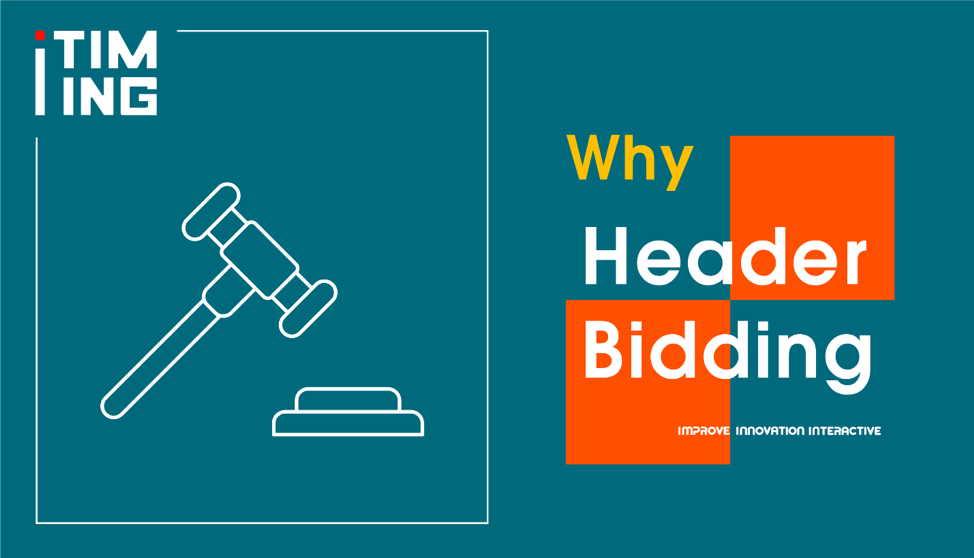2019 has been the year of in-app header bidding.
You might have found a lot of people in the industry are talking about this technique, and that it
can decrease fragmentation between demand sources, improve transparency and achieve higher eCPMs.
Without further ado, let’s now dive into header bidding to see how it increases yields.
What’s header bidding?
Header bidding is a programmatic solution for mobile app developers that increases competition by
making premium ad inventory available to multiple buyers at the same time, the highest bidder wins
and gets the impression.
This bidding method first started with desktop web advertising a decade ago, allowing publishers to
implement code in a web page’s header to send out ad requests. Recent years’ technological
development enabled the mobile app industry to start implementing with similar models, and this is
in-app header bidding.

Before header bidding, waterfall dominated ad stack optimization
Before header bidding, the preferred technique publishers use to optimize ad stacks was waterfall.
For publishers who look to monetize, choosing the right Ad Networks is important. And most
publishers would integrate more than one Ad Network in order to contain risks. However, when the
number of demand partners grows, how to control the traffic for each platform needs to be
considered. Therefore, there comes waterfall.

Waterfall helps publishers optimize remnant ad inventory by creating a bidding priority hierarchy
amongst different Ad Networks, increasing publishers’ chance of selling impressions to the highest
performing Ad Network.
It also improves fill rate. Here is a simple example: a publisher who wants to fill ad requests as
much as possible, would use waterfall to cascade down to lower-weight Ad Networks to fill the
requests unfilled by premium Ad Networks.
Waterfall has limitations
However, there are limitations with the waterfall approach. Key problems amongst these are:
1. Ad request loss
As we all know nothing is perfect, so is waterfall. Its working mechanism naturally determines some
requests might be lost due to latency or timeout problems. With more ad networks in the waterfall,
there is greater chance of losing ad requests.
2. Publishers unable to know the eCPM until the ad is served
The main restricting factor of waterfall is that the eCPMs publishers update daily are based upon
historical values, but ideally, real-time values rather than historical ones should determine eCPMs,
in order to get the highest revenue for publishers.
In fact eCPMs are hardly the same from one impression to another. Fixing on historical values would
also make advertisers with high bids but down the waterfall sequence cannot get a chance to make the
bid.
Above problems lead to lower revenues for publishers. Unlike waterfall, header bidding allows for
different demand sources to bid against each other simultaneously without preferential treatment.
Each impression is auctioned at the highest possible price in real time, so the revenue increases.
Why header bidding?
Header Bidding is a seller technology that let buyers access more of the inventory they want. While
some demand sources pay fixed prices to reserve ads, other decide how much they want to pay based on
user attributes and in real time. With header bidding, buyers now can bid on valued impressions
prior to the ad server ever being called.

Publisher’s ad servers need to know this pricing information from all demand sources ahead of time,
so they can make the right decision about what campaign to show. Ad servers can now intelligently
allocate each impression to the right demand source.
Previously, it’s impossible to have an Ad network to respond to each single ad request, so
publishers were trying to get the highest income from IAA by waterfall. Now with header bidding,
every Ad Network can bid simultaneously for each ad request.
How to implement header bidding?
1. Implement header bidding on your own.
In order to implement in-house header bidding, you’re required to add prebid code to your own
mediation. Notably, having premium demand partners is key to maximizing revenue in this scenario. As
a publisher, if you already have relations with ad exchanges or SSPs, then you are in a good
position to add them as header bidding demand partners. If you haven’t already, it’s highly
suggested to do so.
Since header bidding allows multiple demand sources bidding at the same time, you must make sure you
have enough capability to address timeout issues.
2. Work with third-party mediation platforms
For example, you can implement header bidding by integrating AdTiming SDK as your monetization
solution.
As the leading mediation platform in APAC, AdTiming enjoys extensive connections with over dozens of
premium demand sources. This gives us advantages to run truly unified auctions and accelerate the
adoption of in-app real-time bidding at scale.
What do publishers gain from using header bidding?
We see publishers benefiting from Header Bidding on three fronts:
Transparency by default. As algorithms are
clear and explained, and auctions are fully audited, publishers can see each bid for an
impression coming from demand sources and have control.
Higher earnings.
As aforementioned, header bidding is real-time bidding, different from waterfall where Ad
Networks bid based on historical values. In header bidding, Ad Networks have to bid higher if
they want to win an impression.
Income security.
Working with more demand partners by your own selection means diversification of income, and
reducing the risks of relying on a single demand partner.
To conclude
Header bidding solutions like AdTiming now offer greater efficiency, higher fill rate, increase
publishers’ revenue, and hence enable them to put more time and resources on their apps.
Currently, not all Ad Networks support header bidding. Waterfall is still one of the viable options
when there are fixed eCPM campaigns to be trafficked. Combining the advantages of both techniques to
help publishers with their monetization would be the trend and an effective solution.



 Waterfall helps publishers optimize remnant ad inventory by creating a bidding priority hierarchy
amongst different Ad Networks, increasing publishers’ chance of selling impressions to the highest
performing Ad Network.
Waterfall helps publishers optimize remnant ad inventory by creating a bidding priority hierarchy
amongst different Ad Networks, increasing publishers’ chance of selling impressions to the highest
performing Ad Network.
 Publisher’s ad servers need to know this pricing information from all demand sources ahead of time,
so they can make the right decision about what campaign to show. Ad servers can now intelligently
allocate each impression to the right demand source.
Publisher’s ad servers need to know this pricing information from all demand sources ahead of time,
so they can make the right decision about what campaign to show. Ad servers can now intelligently
allocate each impression to the right demand source.
